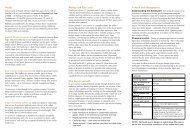Bushland Weeds Manual - Environmental Weeds Action Network
Bushland Weeds Manual - Environmental Weeds Action Network
Bushland Weeds Manual - Environmental Weeds Action Network
Create successful ePaper yourself
Turn your PDF publications into a flip-book with our unique Google optimized e-Paper software.
48<br />
Chapter 4 Corms, Bulbs and Tubers Case Studies<br />
Case study 4.3 Control of Taro (Colocasia esculenta) and subsequent regeneration of the<br />
native plant community – a case study from along the Gingin Brook<br />
Illustration: IFAS Center for Aquatic<br />
Plants 1996.<br />
The study site was located along a<br />
section of the Gingin Brook in the<br />
town site where Swamp Paperbark<br />
(Melaleuca rhaphiophylla) and<br />
Flooded Gum (Eucalyptus rudis)<br />
form the main overstorey in the<br />
fringing vegetation and Tall Sedge<br />
(Carex appressa), Tassel Sedge<br />
(Carex fascicularis) and the fern<br />
Cyclosorus interruptus the<br />
understorey. Where Taro invades it<br />
completely displaces the<br />
understorey and allows no<br />
regeneration of overstorey species.<br />
Small population of Taro, before treatment<br />
May 1999.<br />
Physically removing isolated<br />
population in summer 1999<br />
Physically removing small (up to 10<br />
m x 10 m) outlying populations, was<br />
initially tried in the summer of 1999.<br />
The work was quite labour intensive<br />
with corms weighing around five<br />
kilos and the biomass left to dispose<br />
of significant. Follow-up work was<br />
required for the next two years and<br />
involved removing small plants that<br />
was regrowth from pieces left<br />
behind. Although effective on smaller<br />
populations, physical removal was<br />
not practical for larger infestations.<br />
Herbicide treatment in the<br />
summer of 2000<br />
In December 2000, following some<br />
preliminary trials, all Taro (around<br />
one hectare) was cut to the base<br />
and the bases painted with a 50 %<br />
glyphosate solution. These plants<br />
were up to two to three meters high<br />
and beyond the reach of a backpack<br />
unit. Six weeks later the regrowth,<br />
less than one metre high, was<br />
carefully spot sprayed with a 2 %<br />
glyphosate solution + metsulfuron<br />
methyl (0.05 g/L + Pulse ® 2 mL/L). A<br />
small 750 mL hand held sprayer was<br />
used to carefully target Taro<br />
regrowth. The glyphosate provided<br />
a relatively fast knock-down of top<br />
growth so the area covered could<br />
easily be seen.<br />
A bare open patch was left following<br />
removal in February 2000.<br />
Results from the<br />
monitoring transect<br />
Information collected along a<br />
transect run from the native<br />
vegetation into the Taro infestation<br />
showed the treatment was<br />
effective (Table 1).<br />
Regeneration of the native plant<br />
communities – photo points<br />
from the preliminary trials<br />
Preliminary trials over the summer<br />
of 1999/2000 provided the basis to<br />
treat the entire population of Taro in<br />
this way. Fixed photo points at those<br />
trial sites showed the treatment was<br />
effective. In addition, they showed<br />
rapid regeneration of the native<br />
plant community. Photo points can<br />
provide useful information when the<br />
changes are visually dramatic and<br />
the plant community relatively<br />
simple. In this case the plant<br />
community went from almost 100 %<br />
cover of Taro to 100 % cover of<br />
native species over a couple of<br />
years. Only six species of natives<br />
made up that cover; Tall Sedge,<br />
Tassel Sedge, Swamp Paperbark and<br />
Flooded Gum all spread by seed,<br />
often in water flow, while Cyclosorus<br />
interruptus and Native Knotweed<br />
(Persicaria decipiens) spread rapidly<br />
by vegetative means.<br />
Source: Brown and Brooks (in<br />
press b).<br />
By May 2001 native sedges, ferns and<br />
seedling paperbarks had colonised the<br />
open ground.



